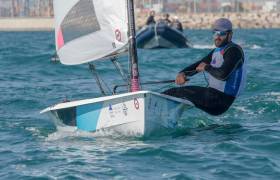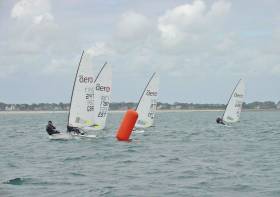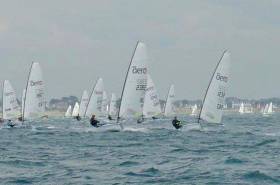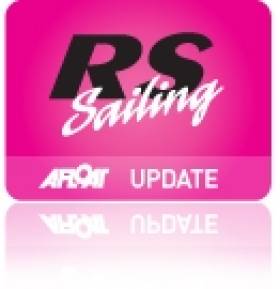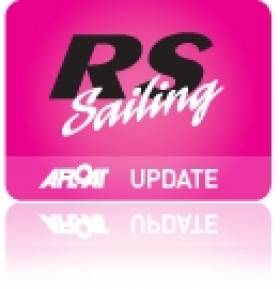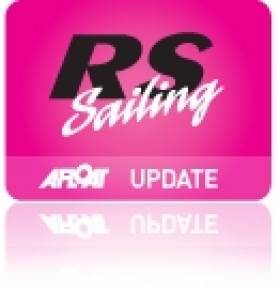Displaying items by tag: rs aero
RS Sailing has issued an open letter to World Sailing in its bid for the men’s and women’s Olympic single-handed dinghy classes currently appointed to the Laser and Laser Radial.
Late last year the RS Aero was selected along with the incumbent Lasers, the Melges 14 and D-Zero from a total of eight bidders for equipment trials for the 2024 Olympic Games in Paris.
More recently, each of these boats (the incumbents excluded) were evaluated in sea trials for men and women in Valencia, Spain in March of this year.
Further trials will be conducted before a final decision is made by December 2020.
But the directors of UK-based RS Sailing — design and tech chief Alex Southon, commercial chief Jon Partridge, sales director Riki Hooker and c-founded Martin Wadhams — are already making their appeal to World Sailing and its member national associations to see the RS Aero as the future of single-handed dinghy sailing at the Olympics.
The full letter is included below:
Dear Mr President and all,
In the coming days World Sailing will make decisions that are likely to affect our sport for the next couple of decades and we feel it appropriate to share our views.
Over the last twenty‐five years we have created RS Sailing and built it into the world’s leading small sailboat brand. We have changed the face of small boat sailing in many parts of the globe, we have made friends on every continent and shared beers in many sailing clubs. We are proud of RS Sailing’s achievements, made not by a few people but by many sailors who believe our sport can be better.
We have not got everything right, but we have listened to the sailors and done our best to create boats and events that are right for the future of our sport. That is why we’re now the brand leader.
We always knew the decision regarding the Olympic single‐hander would be highly charged and the odds are stacked in favour of the incumbent. But the coming decisions are not just about the Olympians; this universal sector drives the youth pathways and the opportunity to build women’s participation as well. The sport is currently in decline in many regions and we all share the primary responsibility to reverse that trend.
The Evaluation was clear. Detractors will always find details to argue but the fact remains the people involved were unanimous in their view that the RS Aero offers clearly the best opportunity – for the youths, women and Olympians.
The boat is ultra‐light, dynamic and better suited to working with a range of rig sizes for light to heavy sailors. It uses high tech construction for competitive longevity. It is backed by the RS organisation, seen as the most capable of delivering consistent high quality to the world through our existing infrastructure and an international FRAND production network on every continent.
Look what happened to cycling when the equipment became light and sexy – the sport exploded.
Conversely, the current Equipment design is fifty years old and heavy. Whatever the rigs, the hull is heavier than many of the sailors it seeks to serve… Lift your bike, ride your bike and think about it...
The issues between the various organisations that build and manage the current Equipment are well documented and long running. They make life harder for many sailors and organisers. Recent communications make it clear that solutions have not been agreed. The issues and potential for litigation against all parties involved distract from growing our sport and threaten World Sailing’s reputation – indeed sailing’s reputation within the Olympic movement.
So, over to you World Sailing. The experts you selected have told you that the RS Aero is the best Equipment for the future of sailing and we have proved ourselves credible partners. The current Equipment was second ranked, even without factoring in ongoing commercial issues.
You can select new Equipment; you can simply ignore the information laid out by the experts and make no change; or you can take some time to consider what is best for the direction of our sport. A smooth transition is possible – perhaps starting with the women’s fleet or the youth pathway.
We offer you a chance to inspire the next generation.
We offer the RS Aero.
Yours,
Alex, Jon, Riki and Martin
Sean Craig Finishes Seventh At RS Aero Worlds
#RSAero - It’s a seventh-place finish for Sean Craig in the Aero 7 at the Rooster RS Aero Worlds in France.
After a gruelling 15 races over five days, the third discard kicked in – allowing Germany’s Marcus Walther and Britain’s Ben Rolfe to knock Ireland’s lone entry in the new ultralight class two spots down the table.
But the Royal St George YC sailor maintained his consistent performance despite the persisting breeze during the week at Carnac, where wind speeds never dipped below 15 knots.
Higher up the table, the battle for first was won by Steve Cockerill over his fellow Briton, and RS class brand manager, Peter Barton.
Sean Craig Fifth After Nine Races At RS Aero Worlds
#RSAero - Sean Craig, Ireland’s lone entry in the Rooster RS Aero Worlds, is currently in fifth place in the Aero 7 division after three days of racing at the Yacht Club de Carnac in France.
As of yesterday evening (Wednesday 26 July), the Royal St George sailor and former RS200 Irish champion is nine races into the competition and showing consistent performance despite the fresh conditions, with strong winds between 15 and 25 knots since Monday (24 July).
The top of the table, meanwhile, remains a battle between Britain’s Steve Cockerill and Peter Barton, brand manager of the RS class.
Launched three years ago, the ultralight RS Aero had its first happy Irish customer in Daniel McNeills of the Royal St George — and also received high praise from Dun Laoghaire’s young Olympic Laser contender Finn Lynch.
European Demo for RS Aero Dinghy Begins
#rsaero – Having already debuted in Ireland, RS Sailing's newest development, the RS Aero, has been in full swing with sailors having their first taste at clubs across the country during a UK demo tour.
The much hyped new craft is ultra-light and simple to rig which RS say it means the dinghy will 'reset the standard for exhilarating sailing'. In Ireland, the boat was tested by youth Laser ace Finn Lynch last month. Vid here.
Today marks the announcement of the European demo tour, starting at Campione del Garda in Italy this Saturday and Sunday 17th and 18th May, followed by Bruinisse in the Netherlands the following weekend – Friday 30th and Saturday 31st May.
With the attractive launch offer of £4,870 stg, pre orders have been placed faster than can be processed, say RS.
First RS Aero Dinghy Purchase for Ireland Goes to Royal St. George YC Sailor on Dublin Bay
#rsaero – 63–year–old Daniel McNelis of the Royal St. George YC is the proud owner of the lastest in dinghy designs following a demo of the ultralight RS Aero dinghy on Dublin Bay earlier this week. McNeilis, an amputee, who is an an RS Vario sailor, says the boat planes nicely upwind and 'tacks in a jiffy'.
The RS Aero has been dubbed the 21st century Laser – with the most fundamental difference being ultra-light weight. A full size single hander that, amazingly, weighs 30kg - the same as an Optimist.
Quick thinking RS promoters McCready Sailboats from Hollywood in County Down also recruited Dun Laoghaire sailing superstar Finn Lynch who said the RS Aero is a fun boat to sail. Lynch, who is aiming for Rio 2016 in the full rig Laser dinghy, also says he found the boat 'very quick'.
The 17–year–old, who won an ISAF youth silver medal in 2012, gave a thumbs up to the simplicity of the 30kg–boat that can be rigged quickly.
After three years of development testing four different hull variations and numerous rig, foil and layout options, RS Sailing unveiled what they say could become one of the most important new sailboats of this era at the Suzuki RYA Dinghy Show in London in March.
RS Aero to be Launched at RYA Dinghy Show
#rs – After three years of development testing four different hull variations and numerous rig, foil and layout options, RS Sailing will unveil what could become one of the most important new sailboats of this era at the Suzuki RYA Dinghy Show in London – the RS Aero.
In many ways you can think of the RS Aero as a 21st century Laser – with the most fundamental difference being ultra-light weight. A full size single hander that, amazingly, weighs 30kg - the same as an Optimist.
Every dinghy sailor can imagine how that changes the game. Sail the boat and you quickly realise you underestimated it. From the exhilaration on the water, to the sheer user-friendliness ashore, the RS Aero re-sets preconceptions: The rush as the boat accelerates - the ability to carry it up the beach single-handed – the convenience of youths or small women lifting it onto a roof-rack with ease.
Ultra-light weight means the hull form and rigs need not be extreme, so the RS Aero is utterly exciting without being hard to handle. Wide structural gunwales give a dry ride and make the boat quick and safe to right from capsize.
A three rig system, as per the Laser, has been envisaged from the start to cover the desired sailor range – RS Aero 5 (youths) – RS Aero 7 (women & light men) – RS Aero 9 (men). Racing will be separate – indeed some variation in event programmes is likely, especially for the RS Aero 5. All spars are carbon fibre, with a common top mast and boom for all sails and radically different stiffness lower mast sections. The hull is so light that even the Aero 5 has a higher sail area to weight ratio than most existing single-handers and retains the Aero's incredibly dynamic feel.
Two v4 pre-production prototype boats will be on the RS Sailing stand at Alexandra Palace. Final stages of the development process are underway, with every aspect of this simple boat having been examined, developed and tested for functionality over fashion, minimal weight, maximum strength and manufacturing efficiency. Perhaps the most remarkable achievement of the RS Aero is that despite being half the weight, built using epoxy resin and significant amounts of carbon fibre in the hull and all-carbon spars, the price will be close to that of a Laser.
UK roll-out of the RS Aero will take place first and a demo tour begins immediately after the Show. Orders are now being taken with a special launch price available on the first 100 boats – over half of which have already been reserved.
All through development, the reaction has been similar: Sir Ben Ainslie sailed an early prototype soon after the 2012 Olympics. Slightly nervous about going afloat due to his still bad back, he then couldn't be coaxed ashore until his next commitment forced him in. Giovanni Belgrano, head of Emirates Team New Zealand's Technical Team, flew straight back from the America's Cup finals to his beach house in Gurnard, Isle of Wight, where RS Aero development sailing happened to be underway. A few hours later his smile was back and he ordered two boats.
From weekend warriors to discerning professionals, the RS Aero re-ignites passion for sailing in its purest, least complicated form. With RS Sailing's global distribution network, worldwide success seems assured.


























